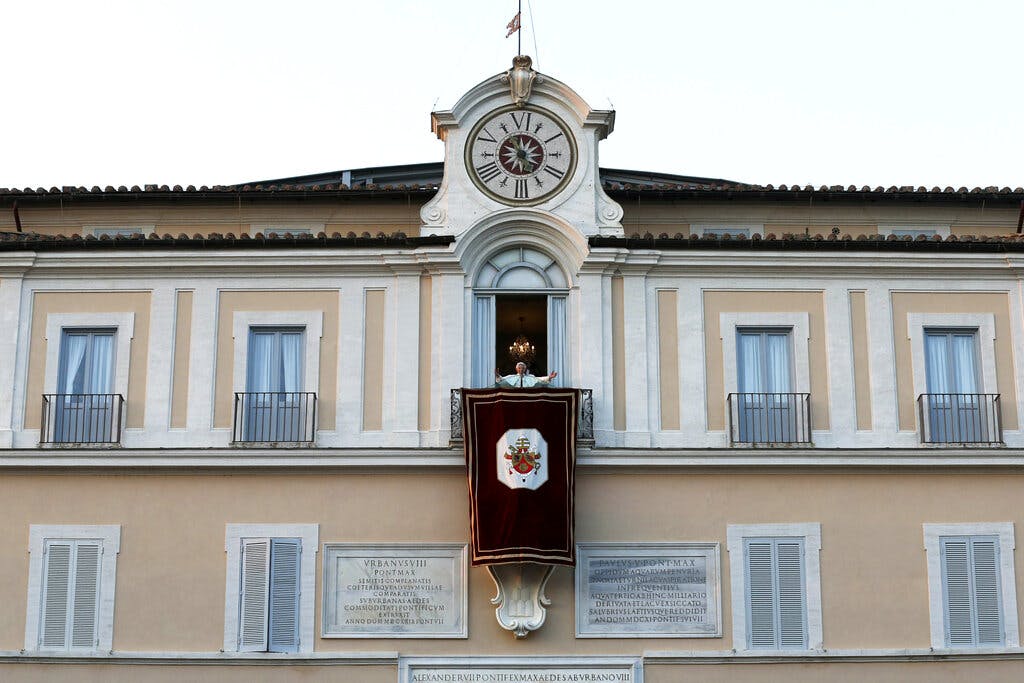At Benedict’s Summer Home, a Town Mourns
Pope Emeritus Benedict XVI is particularly beloved in Castel Gandolfo, where he joined a centuries-long list of pontiffs who summered at the papal villa overlooking Lake Alban in the hills south of Rome.

CASTEL GANDOLFO, Italy — The shopkeeper named her daughter after him. The parish priest wears his old vestments. The former mayor dedicated a plaque to him on City Hall, and residents up and down this picturesque hilltop town reminisce about hearing him play the piano behind the palace walls on cool summer evenings.
Pope Emeritus Benedict XVI is particularly beloved in Castel Gandolfo, where he joined a centuries-long list of pontiffs who summered at the papal villa overlooking Lake Alban in the hills south of Rome. Benedict’s death has hit its residents hard, since many knew him personally, and had already said their emotional farewells when he uttered his final words as pope from the palace’s balcony overlooking the town square on February 28, 2013.
On that night, thousands had thronged Castel Gandolfo’s main piazza and gave Benedict a thundering round of applause as the palace’s brass-studded doors swung shut at 8 p.m., signaling the official end of his papacy.
Benedict then began the first papal retirement in 600 years in the seclusion of the palace’s grounds, where he waited out the conclave that elected Pope Francis. He returned to the Vatican two months later to live his remaining years in a converted monastery in the Vatican Gardens, where he died Saturday, nearly 10 years after that momentous night in Castel Gandolfo.
“It was really awful seeing the big door close that night,” said Stefano Carosi, who runs the coffee shop on the main piazza, a stone’s throw from the palace entrance. “It made us realize that this pope wouldn’t be with us anymore … that he had left us.”
It was Pope Urban VIII who had the palace built on the northern end of town in 1624, to give popes an escape from the sweltering Roman summers. It was enlarged over succeeding pontificates to its present size, which is now bigger than Vatican City itself.
Aside from the extensive gardens and a pool that Pope John Paul II installed, the palace grounds are home to a working farm that supplies the Vatican with fresh dairy, eggs, honey and produce, as well as an observatory that boasts a world-class meteorite collection.
In the decade since Benedict retired, Castel Gandolfo has had to adapt its livelihood and seasonal rhythms to a new pope who has chosen not to vacation here. Pope Francis has spent every summer of his papacy at Vatican City, depriving Castel Gandolfo’s souvenir shops, restaurants and hotels of the visitors who would pack the town each summer Sunday for noon papal blessings and then stay to enjoy a cool afternoon in the countryside.
Pope Francis has tried to make it up to them, opening the palace and its immaculate gardens to the public in an extension of the Vatican Museums, where visitors can see the papal bedroom, vestments and old uniforms of the papal court.
But even with a year-round tourism opportunity, the absence of a pope still rankles a community that for centuries had a privileged relationship with popes, especially Benedict because of his obvious love for the town and his decision to mark his final moments here as pope.
“When he arrived here (at the beginning of each summer) he looked very tired, but just with the two months he spent in Castel Gandolfo he flourished again,” said Mayor Maurizio Colacchi, whose two terms covered nearly Benedict’s entire eight-year papacy. “It was clear that the air, the atmosphere, the tranquility, the serenity were of great benefit for him.”
Mr. Colacchi recalled the visits by heads of state that turned main street into the center of the media universe for a day, as well as Benedict’s lower-profile but more frequent visitor: his late brother, the Reverend Georg Ratzinger, who often spent weeks visiting the pope in summer.
In one of his many papal encounters, Mr. Colacchi gave Georg honorary citizenship. In another, Mr. Colacchi unveiled a plaque on the façade of City Hall with a quote Benedict once uttered in expressing his love for the town. “Here I have everything: mountains, lake and I can even see the sea, and good people,” the plaque reads.
“We got to know him very well, in the sense that we had the fortune of appreciating him in a more direct way than anyone else, because here everything’s smaller,” said Patriza Gasperini, whose family has run Gasperini Souvenirs, a shop right next to the palace entrance, for three generations.
She remembered how Benedict would greet residents in the main square when he would return from his walks in the gardens, without any bodyguards, or when he’d play his beloved Mozart in the evenings, and passersby could hear it faintly in the main square.
“He was very, very good,” said Ms. Gasperini, whose shop still features Benedict-themed religious souvenirs and who named her daughter, Benedetta, when she was born a few months after his 2005 election.
Benedict was remembered with prayer during several moments of the Tuesday morning Mass in the parish church on the main square, where a large photo of him with a black ribbon across the frame was placed next to the altar.
The parish priest, the Reverend Tadeusz Rozmus, donned a white vestment that Benedict had worn during a Mass he celebrated for the Castel Gandolfo faithful in their church and then left behind as a gift.
“The popes who came here didn’t come as guests,” Reverend Rozmus said after Mass. “This was their home.”
Associated Press
